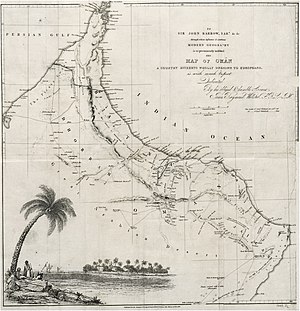This article needs additional citations for verification. (August 2023) |
| This article is part of a series on the |
| History of the United Arab Emirates |
|---|
 |
|
|


The United Arab Emirates (the UAE or the Emirates) is a country in the eastern part of the Arabian Peninsula located on the southeastern coast of the Persian Gulf and the northwestern coast of the Gulf of Oman. The UAE consists of seven emirates and was founded on 2 December 1971 as a federation, after UK armed forces left the region. Six of the seven emirates (Abu Dhabi, Dubai, Sharjah, Ajman, Umm Al Quwain and Fujairah) declared their union on 2 December 1971. The seventh, Ras al Khaimah, joined the federation on 10 February 1972.[1] The seven sheikdoms were formerly known as the Trucial States, in reference to the truce treaties established with the British in the 19th century.[2]
Artifacts uncovered in the UAE show a history of human habitation, transmigration and trade spanning over 125,000 years.[3] The area was previously home to the Magan people[4] known to the Sumerians, who traded with both coastal towns and bronze miners and smelters from the interior. A rich history of trade with the Harappan culture of the Indus Valley is also evidenced by finds of jewelry and other items and there is also extensive early evidence of trade with Afghanistan[5] and Bactria[6] as well as the Levant.[7]
Through the three defined Iron Ages and the subsequent Hellenistic period, the area remained an important coastal trading entrepôt.[8] As a result of the response of Al Azd tribe to the message of Muhammed, the area became Islamised in the 7th century, a position consolidated by the Ridda Wars and the bloody and definitive Battle of Dibba.[9] The Islamic era saw the area emerge once again as an important centre for trade, centred particularly around the ports of Julfar, Dibba and Khor Fakkan.[10] These, linked to the vast Eastern Arab trading network that centred around the Kingdom of Hormuz, formed an important link in the Arab monopoly of trade between the East and Europe.[11] In the late Islamic era, a number of small trading ports developed alongside the development of bustan agriculture in inland oases such as Liwa, Al Ain and Dhaid and tribal bedouin society co-existed with settled populations in the coastal areas.[citation needed]
A number of incursions and battles took place along the coast when the Portuguese, under Afonso de Albuquerque, invaded the area and disrupted the Arab trade networks, triggering a decline in trade and a rise in regional conflict following the fragmentation of Hormuzi authority. Subsequent conflicts between the maritime communities of the Trucial Coast and the British led to the sacking of Ras Al Khaimah by British forces in 1809 and again in 1819, which resulted in the first of a number of British treaties with the Trucial Rulers in 1820. These treaties, starting with the General Maritime Treaty of 1820, led to peace and prosperity along the coast and supported a lively trade in high quality natural pearls as well as a resurgence in other regional trade. A further treaty of 1892 devolved external relations to the British in return for protectorate status.
A British decision, taken in early 1968, to withdraw from its involvement in the Trucial States, led to the decision to found a Federation. This was agreed between two of the most influential Trucial Rulers, Sheikh Zayed bin Sultan Al Nahyan of Abu Dhabi and Sheikh Rashid bin Saeed Al Maktoum of Dubai. The two invited other Trucial Rulers to join the Federation. At one stage it seemed likely Bahrain and Qatar would also join the Union of Arab Emirates, but both eventually decided on independence.
Today, the UAE is a modern, oil exporting country with a highly diversified economy, with Dubai in particular developing into a global city and a hub for tourism, retail, and finance,[12] home to the world's tallest building, and largest man-made seaport.
- ^ "How was the UAE founded?". euronews. 2018-12-07. Retrieved 2023-08-17.
- ^ Balfour-Paul, G., The End of Empire in the Middle East: Britain's Relinquishment of Power in her Last Three Arab Dependencies, Cambridge University Press, 1984, ISBN 978-0-521-46636-3
- ^ Cite error: The named reference
:1was invoked but never defined (see the help page). - ^ "Digging in the Land of Magan - Archaeology Magazine Archive". archive.archaeology.org. Archived from the original on 2012-08-12. Retrieved 2018-09-04.
- ^ "Tell Abraq". sharjaharchaeology.com. Sharjah Directorate of Antiquities & Heritage. Retrieved 2018-09-04.
- ^ United Arab Emirates: a new perspective. Abed, Ibrahim., Hellyer, Peter. London: Trident Press. 2001. ISBN 978-1900724470. OCLC 47140175.
{{cite book}}: CS1 maint: others (link) - ^ Manzo, Andrea; Zazzaro, Chiara; De Falco, Diana Joyce, eds. (2018-11-09), "Bronze Age Reed Boats of Magan and Magillum Boats of Meluḫḫa in Cuneiform Literature", Stories of Globalisation: The Red Sea and the Persian Gulf from Late Prehistory to Early Modernity, BRILL, p. 139, doi:10.1163/9789004362321_009, ISBN 978-90-04-36232-1, S2CID 198516354, retrieved 2023-08-17
- ^ "Ancient Cities of the Emirates". Beyond Dubai: Seeking Lost Cities in the Emirates by David Millar. Archived from the original on 2017-10-26. Retrieved 2017-10-26.
- ^ Donald., Hawley (1970). The Trucial States. London: Allen & Unwin. p. 49. ISBN 0049530054. OCLC 152680.
- ^ Power, Timothy. "The UAE in Early Islamic History".
{{cite journal}}: Cite journal requires|journal=(help) - ^ Reid, Struan (1994). The silk and spice routes, cultures and civilizations. UNESCO integral study of the silk roads. UNESCO. London: Belitha [u.a.] ISBN 978-1-85561-265-5.
- ^ "IMF Data Mapper". Archived from the original on 2007-10-19.